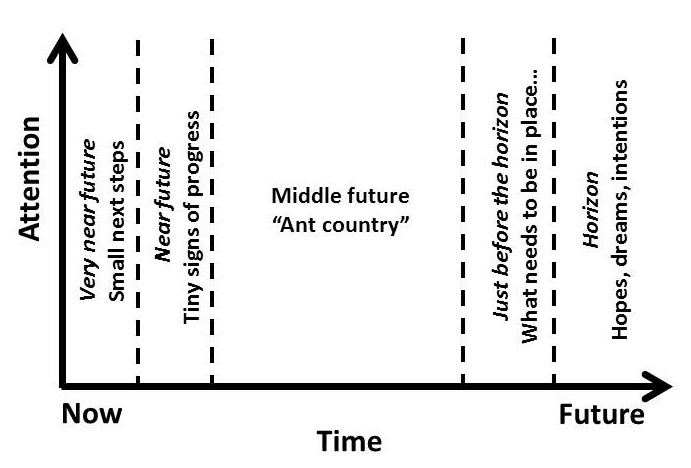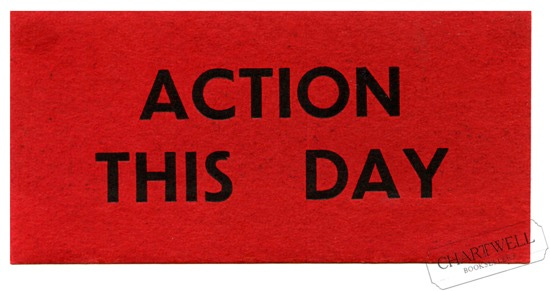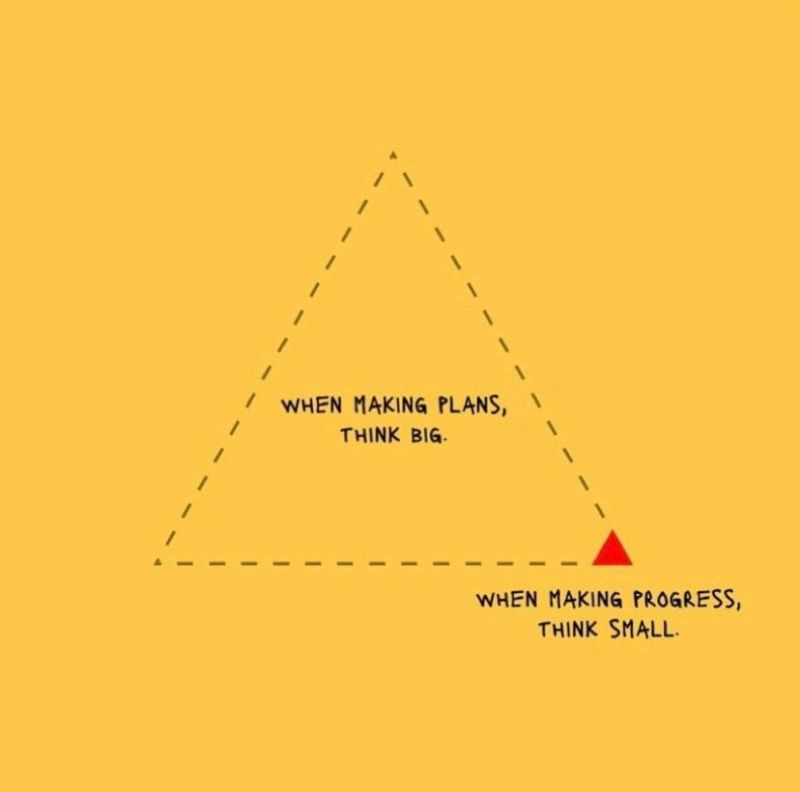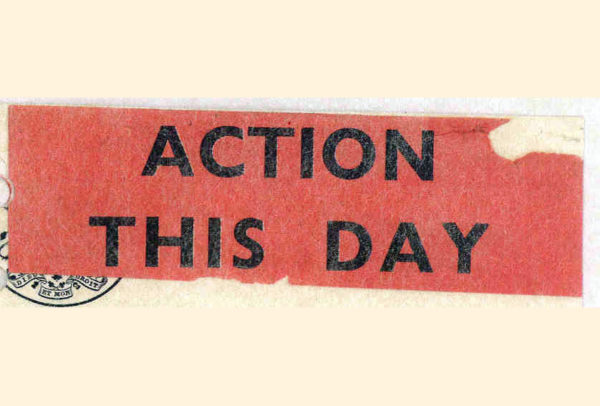29. Small steps and tiny signs: User’s Guide to the Future part 3
Why thinking backwards pays off – even with short term action planning
When doing action planning, we should look forwards, right? Plan some actions and think about the progress that might result. I think it’s better to work backwards – root the actions in the progress you desire. That’s the last part of my User’s Guide To The Future.
The User’s Guide To The Future again again

I’ve been writing here about the User’s Guide To The Future framework the past couple of weeks. The first piece was about the horizon, the distant future where our hopes, aspirations and goals live, and the ‘deep breath moment’ that comes when we (perhaps reluctantly) adjust them. You may recall my story of Sir Chris Bonington on Mount Everest. Last week I wrote about the Ant Country zone, the middle future – too far ahead to plan, but not far ahead enough to be useful in terms of action. While we can prepare for Ant Country, we can’t plan it. If we do, the plans will almost certainly be derailed by ‘events’, the unexpected, unasked-for and inevitable emergence of the world around us.
Humane and effective organising
It’s worth briefly looking at how these two zones are helpful in the overall mission of organising both humanely and effectively. Generally organisations with a solid purpose, good long-term aims and worthwhile goals will be more successful than those which stumble along from one crisis to another in the vain hope that simply keeping going will be sufficient, hoping that something will turn up a la Mr Micawber (the famous procrastinator in Charles Dickins’ David Copperfield). So far so good. But what often happens then is that the former organisations seek to plan their way to success, and then find that sticking to the plan becomes more important than the actual evolution of the work. KPI are agreed, budgets are set… and then hitting the budget becomes more important than actually achieving something useful. This is ‘predict and control’ management, a good way to be ineffective and also start to drift towards a culture of brutality by holding people to account for things that are no longer required or useful.
The near future
Let’s turn our attention to the near future in the User’s Guide diagram above. As you can see, there are two elements:
The very near future: Small next steps
The near future: Tiny signs of progress
The first thing to think about is that, in the User’s Guide approach, these are both shaped by the horizon and the precursors and building block in the distant future. The whole point about having long-term hopes and goals is not for some feeling-good purpose, it’s about affecting what we do TODAY. I wrote about this as long ago as 2009 in the run-up to the UN Copenhagen Climate Change Summit. The press were all focused on whether a long term target for emissions would be reached (it was). In a piece entitled ‘Beyond Targets: How Goals Are Not The Answer (in Copenhagen or elsewhere), I argued that the mere act of agreeing a goal or target was not an end in itself. The key thing to look for was not the target, but the action it produced the next day. As I wrote then:
In my view, the success of Copenhagen should be judged not on long term targets, but on the number – potentially billions – of small actions taking place in the days and weeks that follow.
This is what makes the User’s Guide so powerful. It helps us connect distant hopes and goals with action and progress right now, without getting bogged down in futile planning and worrying about Ant Country. What creates progress towards the horizon is (of course) what we do today and tomorrow, and how we join up the progress by noticing useful change and amplifying it – the heart of Solutions Focus (SF) work. If something doesn’t matter today or tomorrow, we might say it doesn't matter at all.
Back to the future
In all the User’s Guide pieces I have stressed the importance of working right to left (on the diagram above). Work backwards to get the future. This is still true even in the near future zones. One key learning from the past three decades and more of SF working is ‘signs before steps’. So, having established some long-term directions and precursors/building blocks, keep working back from the future to now.
The near future: Tiny signs of progress
This is a really key area of conversation in SF work. Here’s how to get it moving:
“Thinking about [building block A], what would be the first tiny signs of progress you might notice in the coming weeks?”
This is sometimes followed by a pause as the person thinks… and then comes up with a sign. We can then deploy on of the most important SF questions:
“What else?”
I like to get at least 3-4 signs of progress. Don’t give up having gotten one – there are always more lurking around and it helps to get a broader picture. We can then move on…
The very near future: Small next steps
In the context of working with the User’s Guide framework, I am still very happy to be asking about small next steps. Some of my colleagues think that having a good list of tiny signs of progress is enough; the person concerned will have already worked out what they might do, and we don’t need to take their time asking useless questions to which they already know the answer. A useful question, in SF terms, is usually about something new, somewhere the person hasn’t been before, or some new aspect of an existing situation.
I come from an organisational/management background, where getting some understanding of next steps is very normal. The key thing in SF working is to aim for next steps that are:
Small. Really small. So small they are clearly achievable in minutes, hours or at the most days
For the person to do themselves. This may sound obvious but it’s sadly common to see huge actions being taken on. Having the idea to, say, rewrite the marketing plan is fine, but it’s not a small next step in this context. (A small next step might be to contact someone else with a view to engaging with them, of course. Or setting up a call. Or emailing them. Or something even smaller.)
A move towards one or more of the tiny signs of progress. I don’t usually ask about small next steps for each tiny sign. It’s more that they are out there and are part of the discussion. Trying to end up with small next steps for each sign seems a bit mechanistic to me. What we want is action, this day (as Winston Churchill used to write on documents during World War II).

Following up
While we’re on the subject of getting into action, let’s think about how to follow up with the people who wanted to get things moving and devised some small next steps. A predict-and-control manager will ask:
Did you do the agreed actions?
This is not about what’s been achieved, it’s about obedience and subservience. The focus is on doing what you said you’d do, whether or not it’s made any difference. I am all in favour of people being accountable and taking responsibility. This question sounds connected with that but it isn’t; it’s about the past, about the manager seeking control. A much better follow-up question is:
What’s better (with this project)? What progress have you made?
This is about what’s happened that’s useful, not whether the actions were done or not. They may well have been done, in which case it’s much more useful to look to the future about ripples being created and others getting engaged. Or the actions may not have been done, because something else happened, other ways of making progress presented themselves, or new information came to light that changed things.
What we want is a sense of progress (things moving forward), agency (we are part of that and have an influence) and direction (is this connected to the distant future hopes and goals)? When this is to the fore, we have potential for moving forwards in a humane and effective way. Indeed, one of the organisations of which I am chair always start our meetings with:
What have you been pleased to notice recently?
We all chip in with events and developments from the past few weeks, which is a great way to start the meeting. It’s encouraging, we share credit for what’s happened, and it gets the meeting off on a positive and energised path. Try it next time you’re in the chair.
Conclusions
The User’s Guide to the Future is a useful framework for:
Getting moving on big and ill-defined future hopes
Connecting future hopes with what’s happening today
Helping clarify priorities and next steps
Relieving stress when everything seems like a blur and you don’t know what to do next.
And avoid trying to plan your way through Ant Country! That may be the most important idea of all. Now, what are YOUR next tiny signs of progress?
Please remember to like and share this post below. Thank you.
Dates & Mates
On the very day I was writing this piece, David McLean published a very generous post on Linkedin about the power of small steps. Thank you David! It’s very well worth a read. I also loved David’s accompanying diagram:




